Coming through the Boca Juniors youth setup, Nahuel Molina (175cm/5’9”, 70kg/154lbs) struggled to make an impression in the Boca first team. During his loan spell at Defensa y Justicia, Molina started well before fading away onto the bench. Joining Rosario Central on loan at the start of 2019, he became an integral defender, playing full 90s in their six Copa Libertadores group stage fixtures.
Despite his consistent performances at right-back in Rosario, Boca failed to give Molina opportunities after returning. This prompted a move to Europe; precisely, Udinese Calcio on a free transfer.
At Udinese, Molina joined fellow Argentines Juan Musso, Rodrigo De Paul, Roberto Pereyra and Ignacio Pussetto. Adapting to his new wing-back role, Molina eventually became a starter in late February of 2021. Since then, the Argentine has flourished in this role, combining well with De Paul and Pereyra, in particular. His end-of-season form earned him a call-up to the Argentina national team for their historic 2021 Copa América triumph with Lionel Messi.
Last season couldn’t have gone better for Molina, becoming a key starter for La Albiceleste in their World Cup qualifiers at right-back whilst increasing his output at Udinese. His performances for club and country merited a transfer to the highest level, with Diego Simeone bringing his compatriot to Atlético de Madrid for a reported £18m.
In this tactical analysis, in the form of a scout report, we will look at Nahuel Molina’s style of play as he looks to solve Atléti’s right-back problem.
Right width holder
Despite his occasional appearances on the left for Rosario Central, Nahuel Molina has become a dominant force on the right flank. For both Argentina and Udinese, Molina has assumed responsibility for providing width on the right. In the early stages of his Atléti career, the new signing looks to have taken on the role of the right-width holder. With Udinese and Atlético Madrid having some similarities in their approach — both utilise the 3-5-2 formation, for instance — Molina will be familiar with what is required.
In these formations where the wing-backs are typically the only wide players, they must fulfil the responsibility of maintaining maximum width. With the number of central players, the wide players must stretch the opposition horizontally to enlarge spaces between the opponents in central areas for their teammates to combine and penetrate. If the opposition look to maintain central compactness, there is an opportunity to access the wide player in space.
An example of this can be seen below from Atléti’s opening La Liga fixture at Getafe. With left-sided centre-back Reinildo Mandava receiving no pressure from Getafe, the Mozambique international can carry the ball into midfield. Reinildo creates a better angle to execute a switch of play to Molina holding maximum width on the right flank.
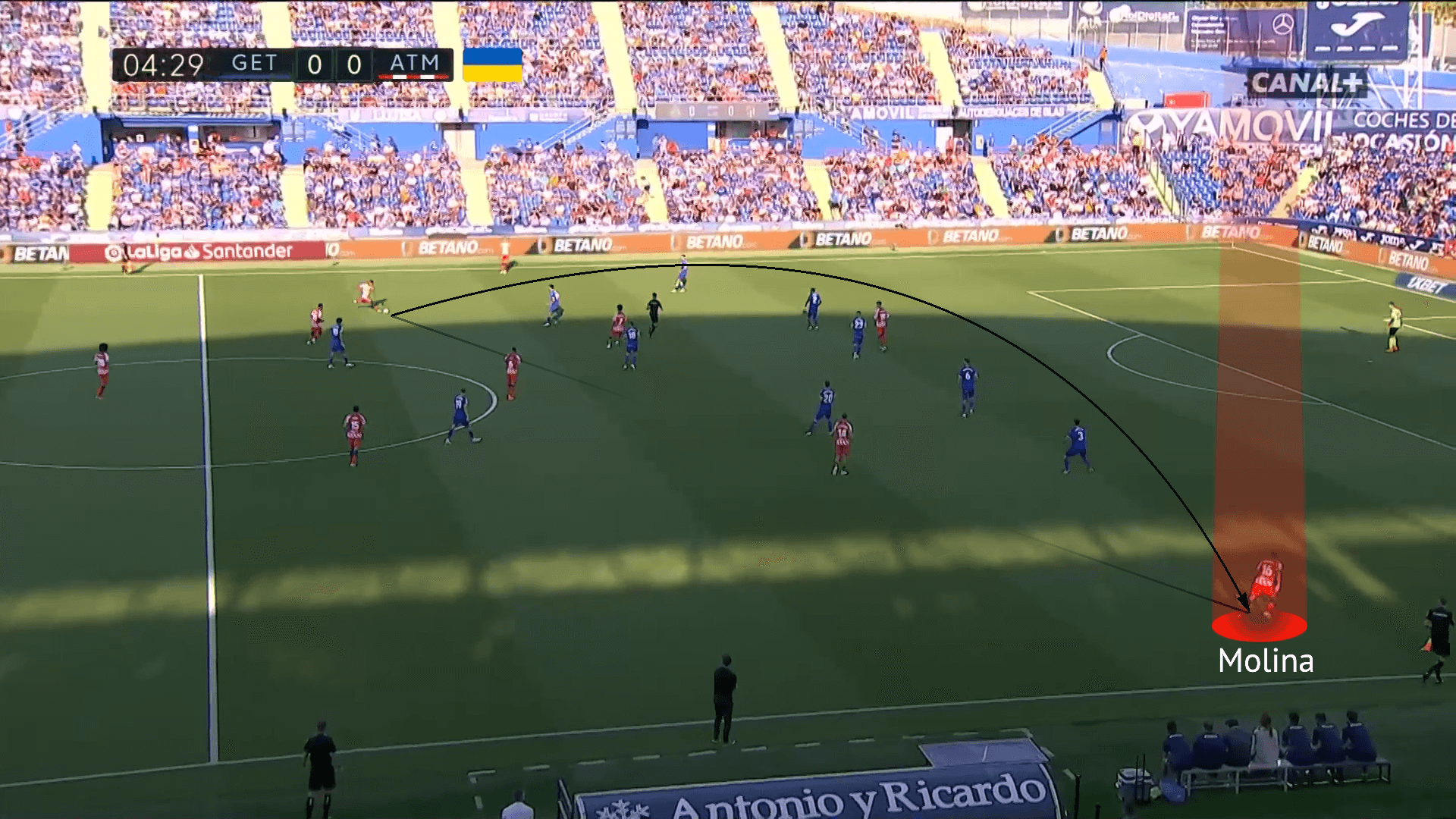
Although Lionel Scaloni deploys a back four with Molina at right-back for La Albiceleste, the 24-year-old is also their most consistent width holder on the right, with Scaloni selecting left-footers with a tendency to drift inside off the right, such as Lionel Messi, Ángel Di María and Giovani Lo Celso. Therefore, it is optimal for the right-back to provide width.
In the example below, we can see both Argentina full-backs joining the forward line and acting as width holders. By doing this against Estonia’s back five, Argentina can create more of a 2-2-6 shape in possession to outnumber the Estonia defence. From the front six, Messi, Julián Álvarez or Papu Gómez can effectively drop to create as well. This shape has also been used by Pep Guardiola’s Manchester City recently against Bournemouth’s back five.
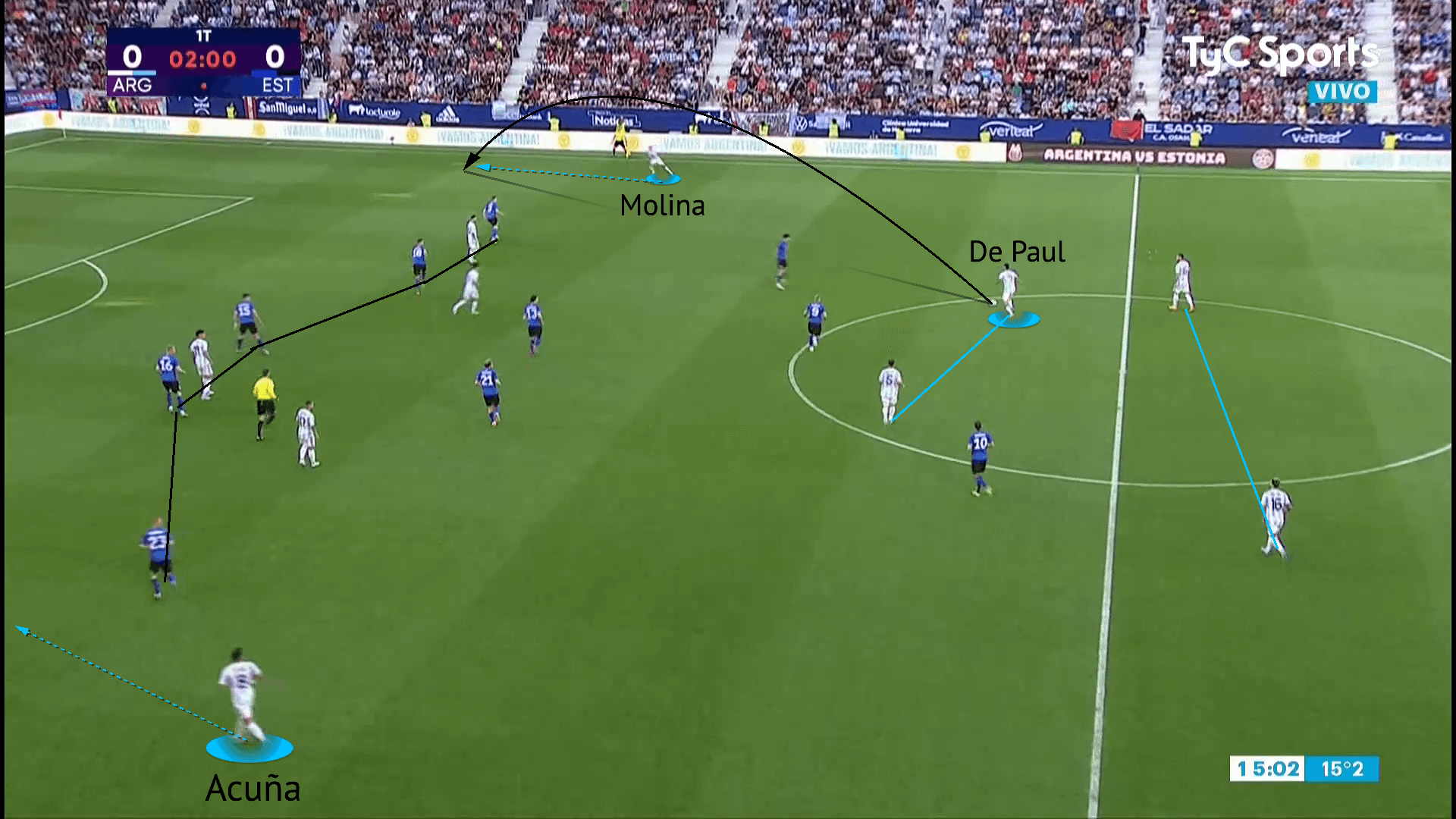
Primarily the right width holder for his recent teams, Molina has also displayed the ability to invert and sit deeper to combine with teammates. With his aforementioned Argentina teammates all comfortable on the right wing, Molina recognises when to maintain team shape.
Molina has stayed behind the ball when more teammates have committed themselves forward but has also inverted high into the right half-space in the forward line when an attacker has moved wide. Effectively, he is a player that understands the core principles of positional play, which is required when playing alongside roaming players like Messi and João Félix.
Below, we can see a triangle of Molina, Messi and Rodrigo De Paul as the right-width holder to retain possession. This could also be seen at Udinese with Roberto Pereyra and Gerard Deulofeu.
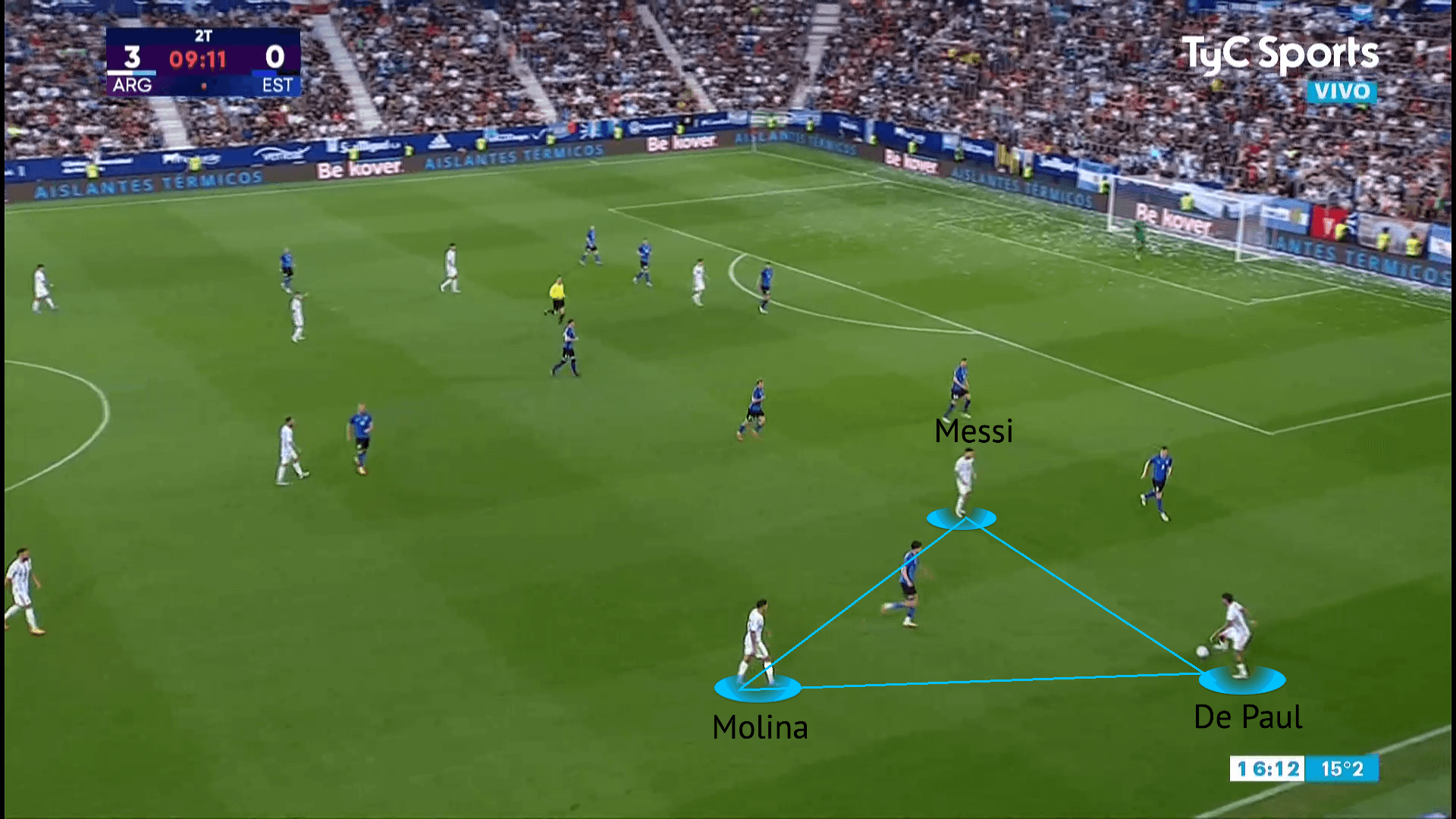
Molina can also combine with teammates whilst acting as the right width holder by the touchline. Occasionally, it looks as though Molina has his head down when in possession but his ability to retain possession and penetrate in tight areas on the wing indicate great peripheral vision.
This will be particularly beneficial at Atléti, with Molina’s ability to slip passes into the underlapping runs of Marcos Llorente and De Paul. His technical efficiency and ability to execute actions with minimal touches help ball retention but also his ability to progress and penetrate via one-two combinations.
Additionally, Molina’s peripheral vision and footwork provide the option of coming infield in possession or dribbling past his opponent. As the width holder, he can beat his man in an isolated 1vs1 as a threat in duels. Last season at Udinese in Serie A, the Argentina international completed 2.34 dribbles per 90 with a 65.75% success rate, and 2.12 progressive runs per 90.
Attacking influence
Nahuel Molina combines effectively with teammates in all phases on the right wing, demonstrating this well in the build-up phase and when looking to enter the final third to create. His previously mentioned dribbling ability means he can carry the ball infield or on the outside, whilst also creating separation in 1v1 duels and producing a passing lane.
Molina also seems to possess the required technical fundamentals regarding body shape and positioning when executing dribbling and passing actions. This also opens passing angles and is productively paired with his fantastic ball-striking.
His ability to play a variety of passes at different angles to progress possession is aided by his two-footedness. By being ambipedal, Molina can execute passes and ball manipulation with clean technique off both feet. This is extremely effective in the build-up phase against opposition pressing due to his ability to create passing angles off both feet. As a result, he has solutions for the opposition’s out-to-in or in-to-out pressing strategies.
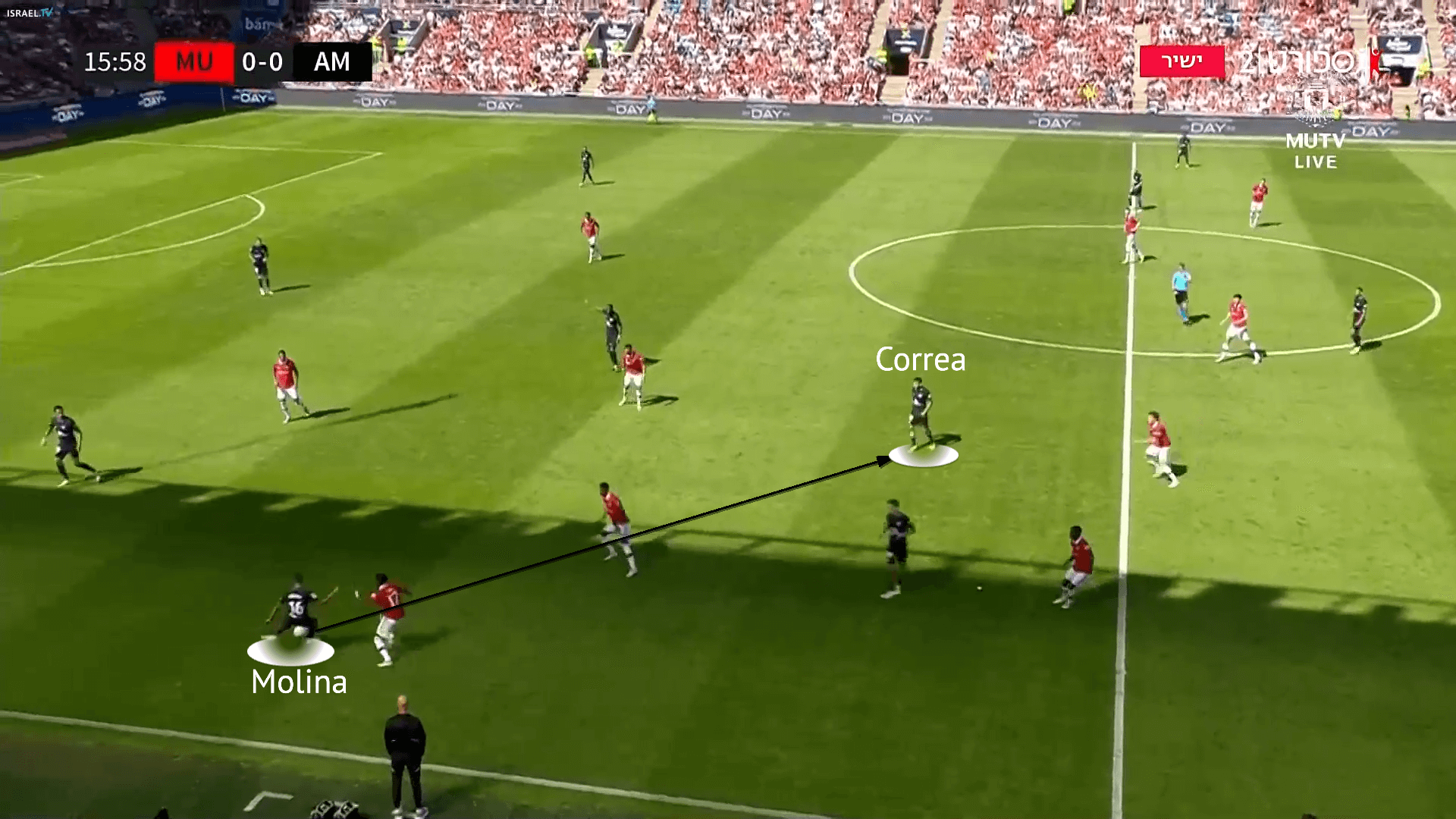
In the above image against Manchester United, Fred has jumped out of the United defensive structure to close down Molina. Fred has left his man, Marcos Llorente, forcing left-back Tyrell Malacia to rush out and Marcus Rashford to drop into the passing lane. However, Molina takes a big touch infield with his right foot, creating separation from Fred and allowing the new signing to play a left-footed pass to Ángel Correa.
Last season, the Argentina international completed 34.95 passes per 90 with a pass completion rate of 73.62%. His forward passing accuracy was 65.53%, attempting 3.69 long passes per 90. His ball-striking off both feet and ability to come inside or stay wide helps his attempts to progress possession, executing firm passes with confidence.
Despite his role at Udinese being aimed more toward final third impact, Molina still completed 4.27 passes into the final third per 90. Out of the 76 full-backs to play over 500 minutes in Serie A last season, Molina ranked 35th for passes into final third per 90. His 8.38 progressive passes per 90 with an accuracy of 73.56% both ranked him 26th, and his 0.71 through passes per 90 ranked 16th.
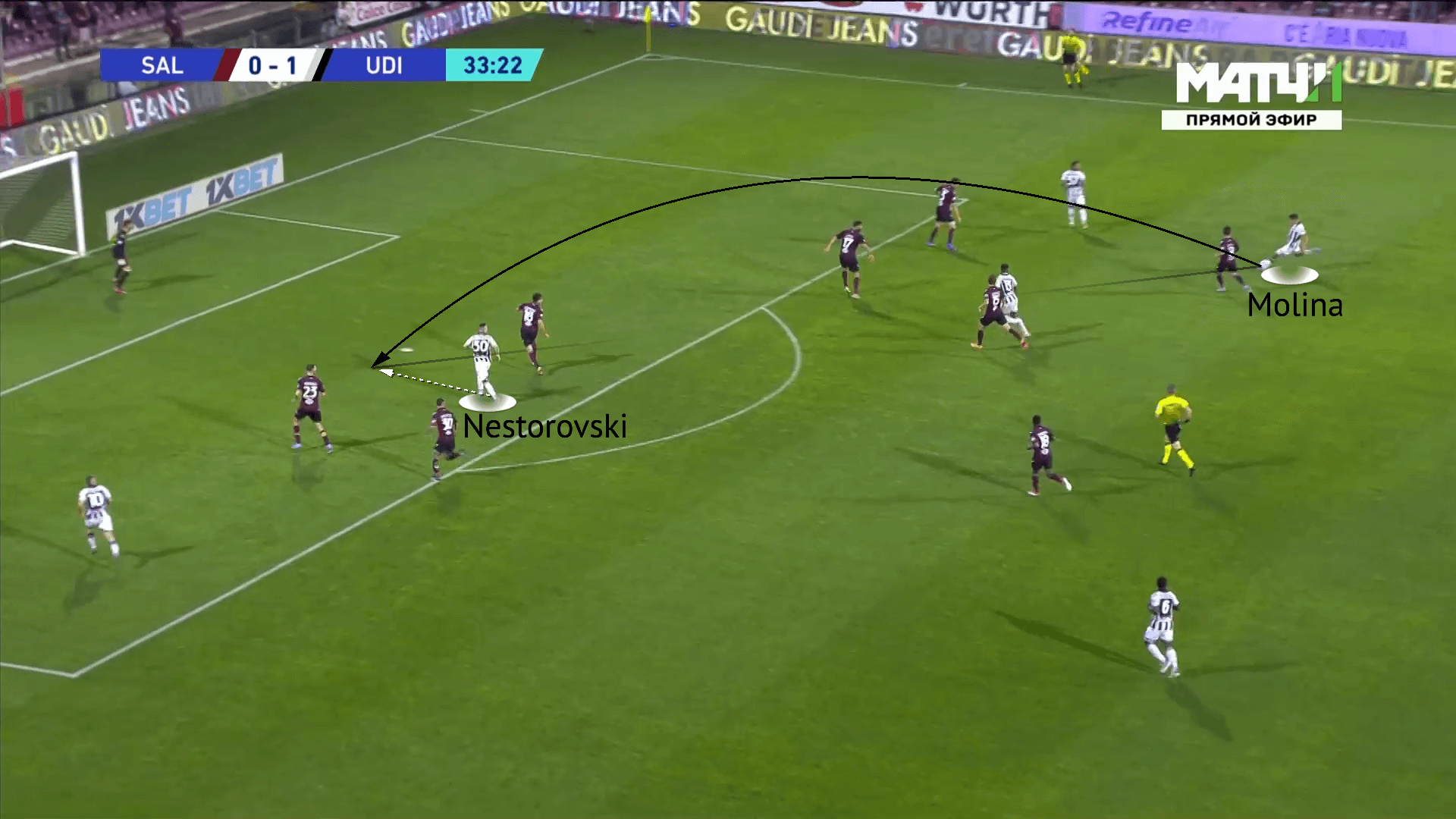
Although the above statistics show his ability to progress possession, Molina’s attacking influence peaks in the final third. His 3.66 passes into the opposition penalty area per 90 rank him 7th out of the 76 Serie A full-backs. Atléti’s new signing ranked 21st for key passes with 0.45 per 90 but his 4.1 xA ranked 5th. However, Molina only registered two assists from the 4.1 xA.
Molina’s 3.24 crosses per 90 with an accuracy of 42.57% is much more than teammate left wing-back Destiny Udogie’s 0.82 crosses per 90, who has signed for Tottenham Hotspur for over £15m.
Last season, Udinese attempted the fewest crosses in Serie A with 392, but 256 of the crosses came from the right flank. Meanwhile, Atlético Madrid attempted 567 crosses last season, with a majority of their crosses also from the right flank.
The figure above displays a Molina assist with a lofted cross for Macedonian striker Ilija Nestorovski to convert with a header. With last season’s attacking options of Beto (194cm/6’4”), Isaac Success (186cm/6’1”), Nestorovski (183cm/6’0”), Pussetto (180cm/5’11″) and Deulofeu (177cm/5’10”), Udinese crosses tended to be lofted deliveries. Out of Beto’s 11 Serie A goals, four of them were headed goals.
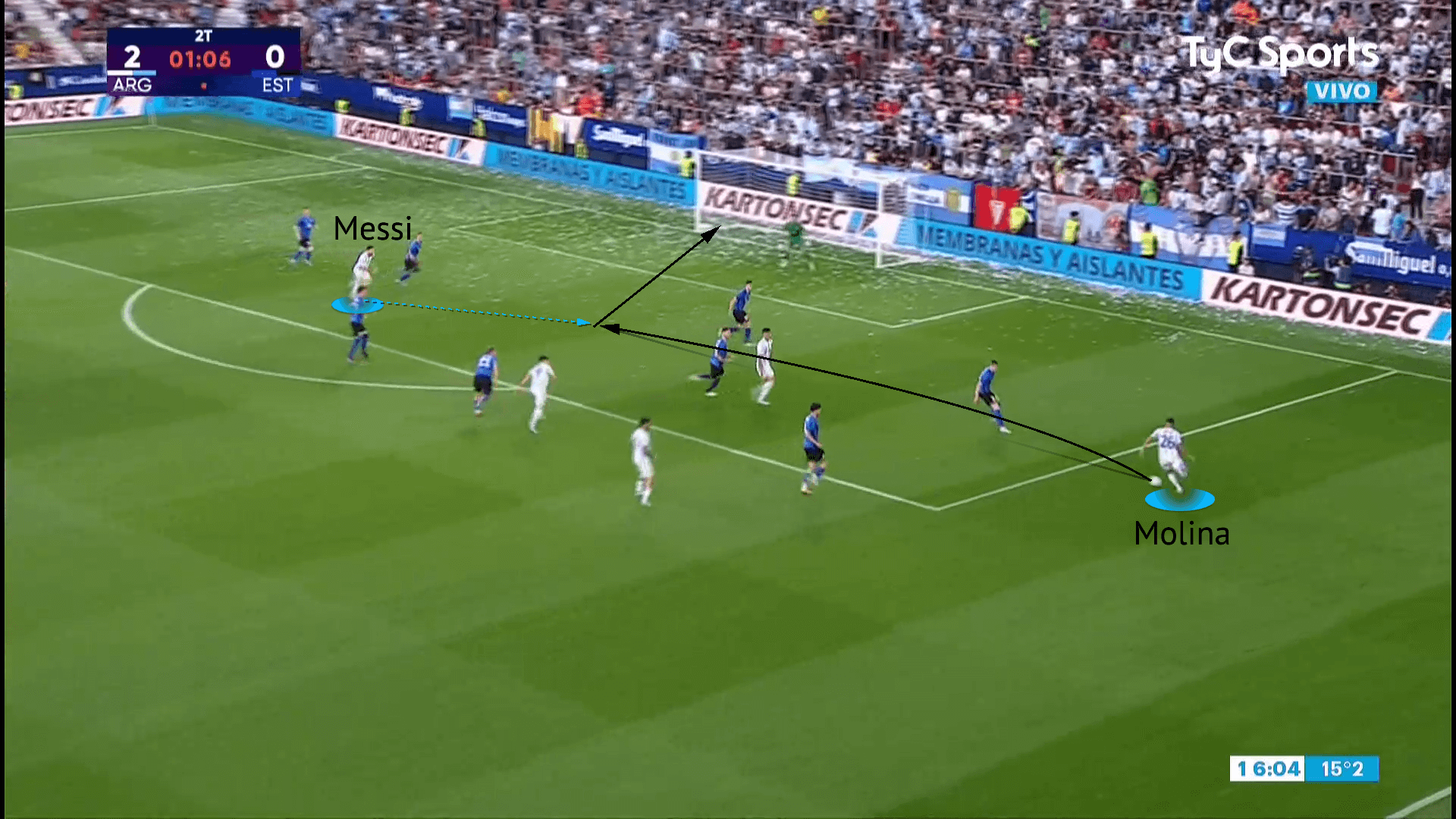
Meanwhile, with the attacking talents available in the Argentinian national team, their profiles are better suited to lower crosses and cut-backs. For example, in the image above, Molina delivers a low ball with pace to Lionel Messi, who places the ball into the corner.
Molina has variety in his deliveries, which will be valuable for Atlético Madrid and their range of attacking profiles, from Álvaro Morata to João Félix. He is also composed inside the box, able to find teammates in a congested area or under pressure. The figure below displays Molina sliding a well-weighted cut-back into fellow Argentine Nehuén Pérez, whose shot was blocked.
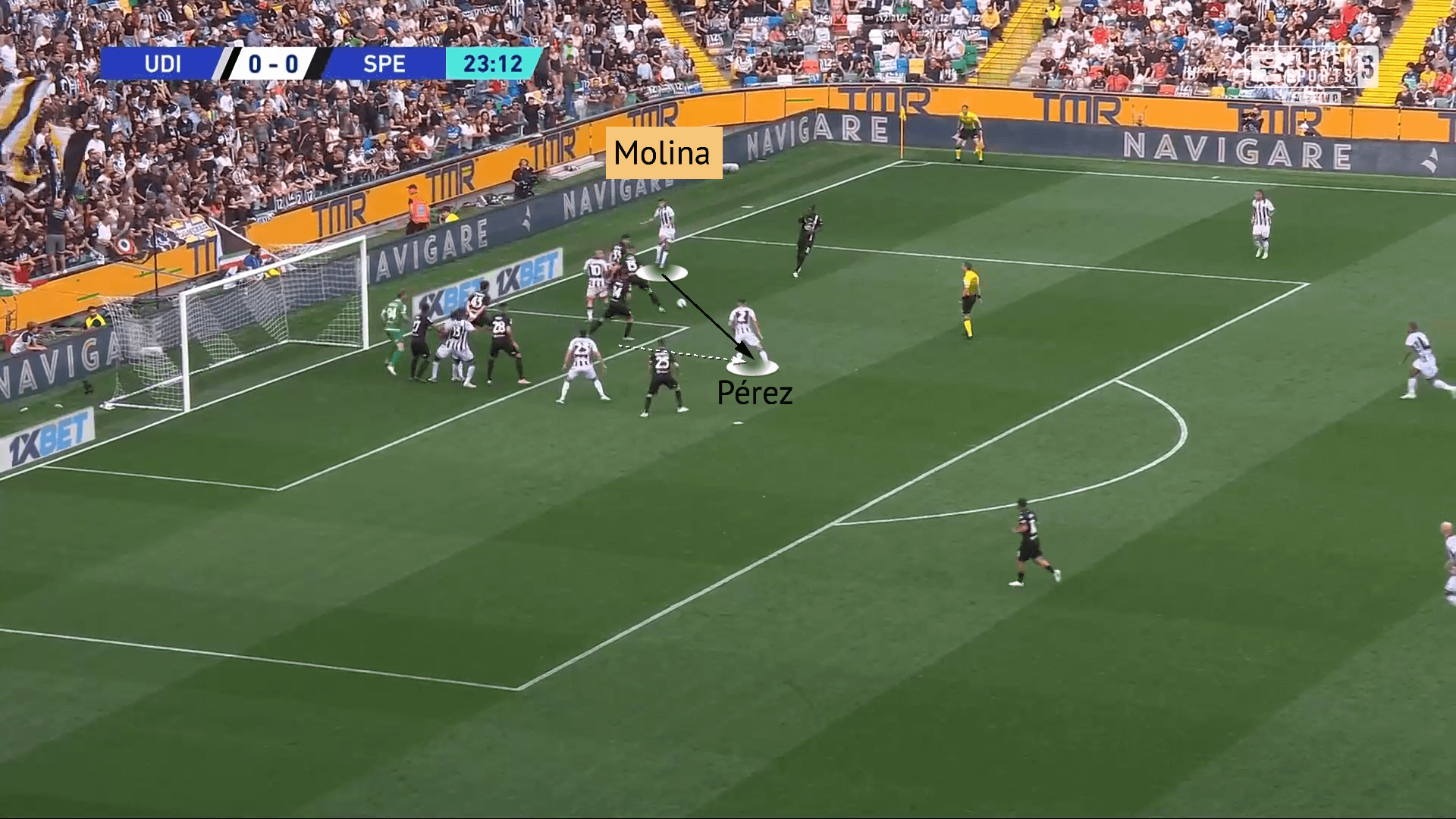
Molina is always eager to attack the box, especially in transition, driving forwards from deep. The Argentina international was the top-scoring full-back in Serie A last season with seven goals from 4.76 xG. Only Udogie accumulated a higher xNPG, but Molina attempted the highest number of shots with 43 and 37.21% on target.
Out of his seven goals, four were right-footed with the remaining three coming from his left foot — showing his ambipedal ability. By occupying spaces in and around the box, Molina can show his exceptional ball-striking. His goals last season included powerful long-range strikes and volleys, and controlled finishes with a speculative chip over then-Cagliari goalkeeper Alessio Cragno.
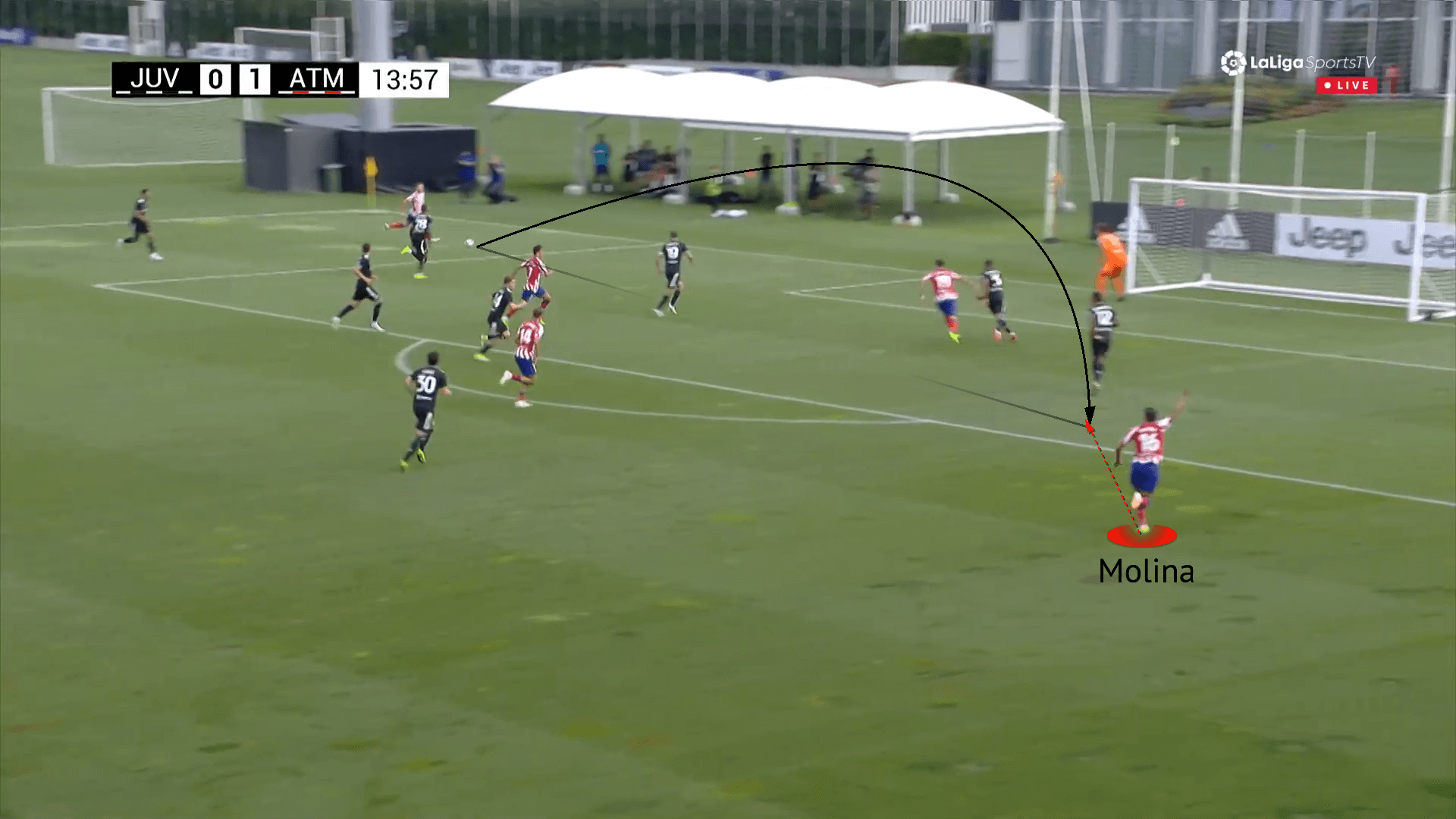
Out of possession
Nahuel Molina is brilliant going forward, but the former Udinese man can have issues defensively. He contested 5.52 defensive duels per 90 in Serie A last season, but his success rate of 49.42% ranked 72nd out of the 76 full-backs to play over 500 minutes in the competition.
Molina rarely dives into tackles, tending to stay on his feet during ground duels. He uses his upper body well, getting his arms across opponents attempting to beat him on the outside in 1v1 duels. His 4.38 PAdj interceptions ranked 63rd out of the 76 Serie A full-backs.
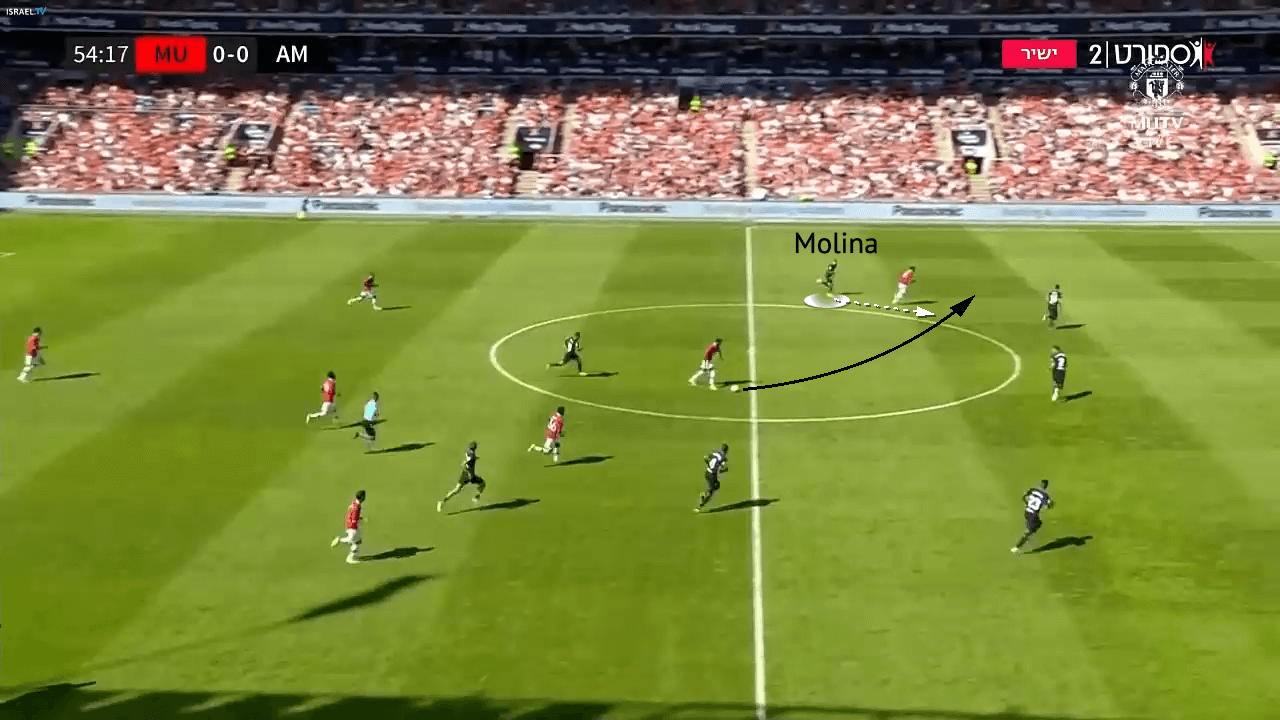
With his high positioning during in-possession phases as a right wing-back, his recovery runs and work in defensive transition must be fantastic. The Boca academy graduate is also a tenacious presser of the ball.
The image above is an example of Molina’s exceptional tracking back, coming inside and cutting the passing lane into Anthony Martial to intercept Rashford’s poorly-weighted pass. In a more settled defensive structure, Molina has also displayed his awareness to narrow and readily drop behind the defensive line to provide cover and balance.
With his relatively small figure, the Argentine tends to avoid aerial duels. Of course, this is also impacted by the fact he primarily plays as a wing-back rather than a full-back, where fewer aerial duels are common.
Out of the 76 Serie A full-backs/wing-backs, only Roma’s Rick Karsdorp contested fewer than Molina’s 0.96 aerial duels per 90. Meanwhile, his aerial duel success rate of 40% is just below the full-backs average. Despite this, Molina has shown his ability to deal with crosses and defend when overloaded.
In the figure below, Saúl Ñíguez is caught ahead of Juventus attackers Dušan Vlahović and Matías Soulé, with Alex Sandro arriving behind Molina towards the back post. Luckily for Atléti, the cross from Leonardo Bonucci sailed over Vlahović and Soulé, and Molina remained calm to cushion the ball down for goalkeeper Ivo Grbić to collect.
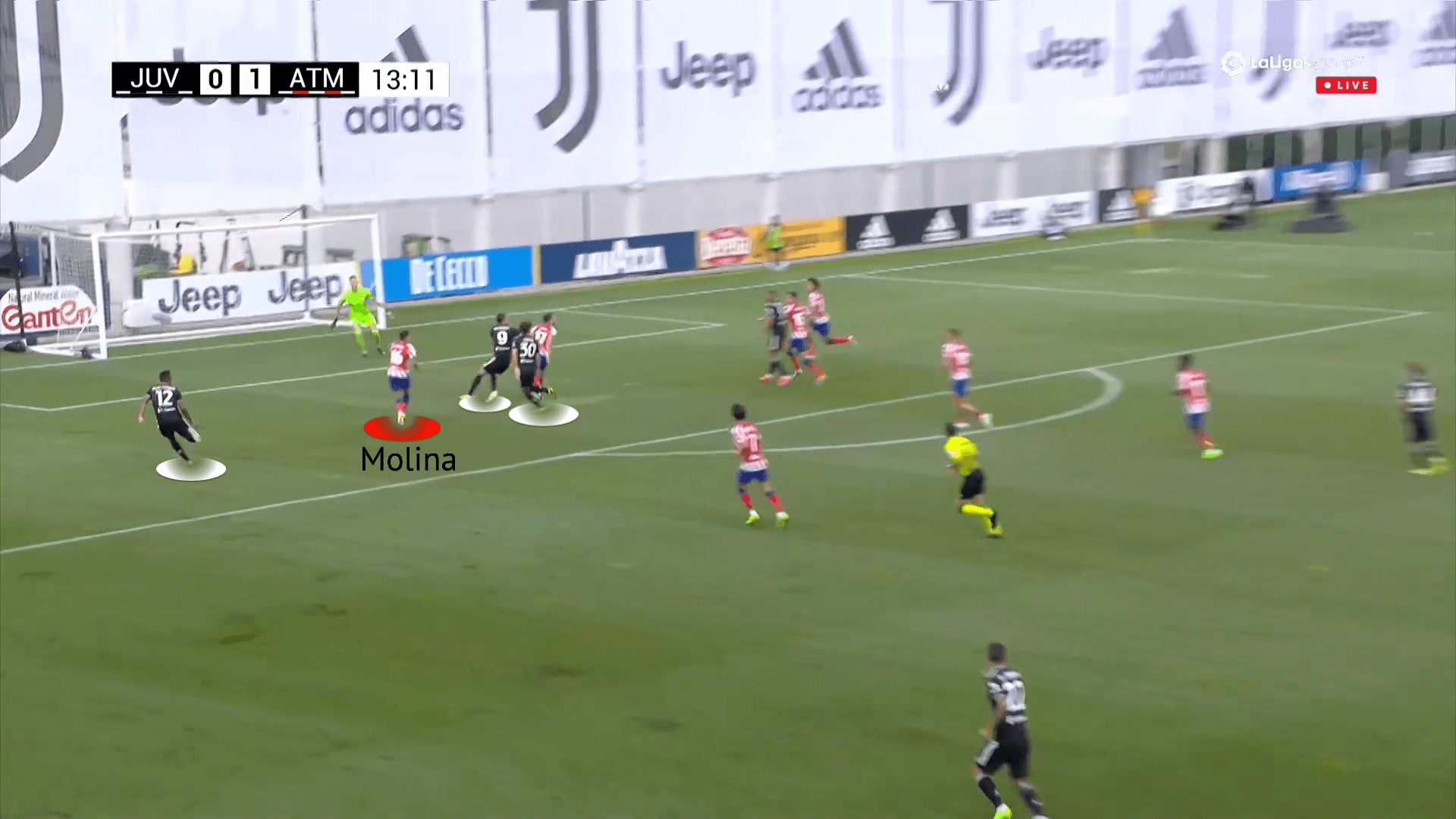
Conclusion
In an area that Atlético Madrid have struggled to fill since Kieran Trippier’s January departure to Newcastle United, manager Diego Simeone has chosen his compatriot Nahuel Molina to come in and dominate the right flank.
The £18m arrival from Udinese must hit the ground running for the Rojiblancos of Madrid to prevent the recurring issue of deploying the excellently well-rounded midfielder Marcos Llorente in the right wing-back role.
Molina is an adaptable player, aided by his ambipedal ball-striking and technical efficiency. His role at Udinese under Gabriele Cioffi has many similarities to what will be expected from the new signing at Atléti.
He provides elements of Yannick Carrasco’s and Renan Lodi’s game, whilst replacing Trippier’s dangerous deliveries from the right wing. Despite his mixed defensive quality, Molina looks to be an astute acquisition for Simeone’s side at the Wanda Metropolitano.
Alongside the UEFA Champions League and La Liga experiences that await in this upcoming season, the 2022 FIFA World Cup in Qatar will also be a huge occasion for Molina. Expected to be the starting right-back for Argentina alongside club teammate Rodrigo De Paul, he will be looking to play his part in a potential long-awaited World Cup victory for La Albiceleste. Coming off the back of Copa América and Finalissima triumphs, as well as an unbeaten World Cup qualification, Lionel Scaloni’s men will have confidence.
In this analysis, we have looked at Nahuel Molina’s ability as a right-width holder and how the Argentina international influences his team’s attacks and defensive quality and tactics ahead of an exciting yet crucial season in his career.

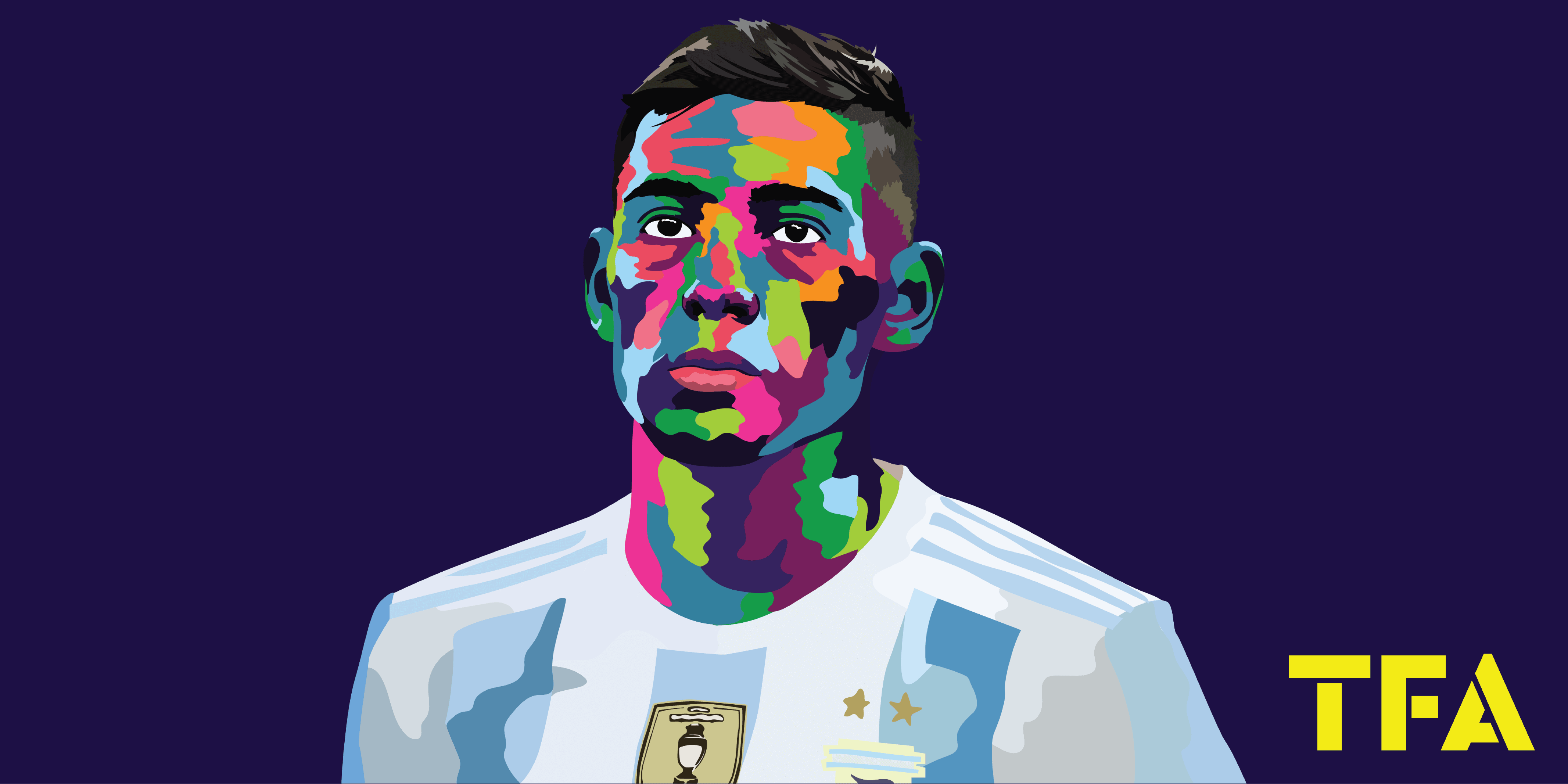




Comments